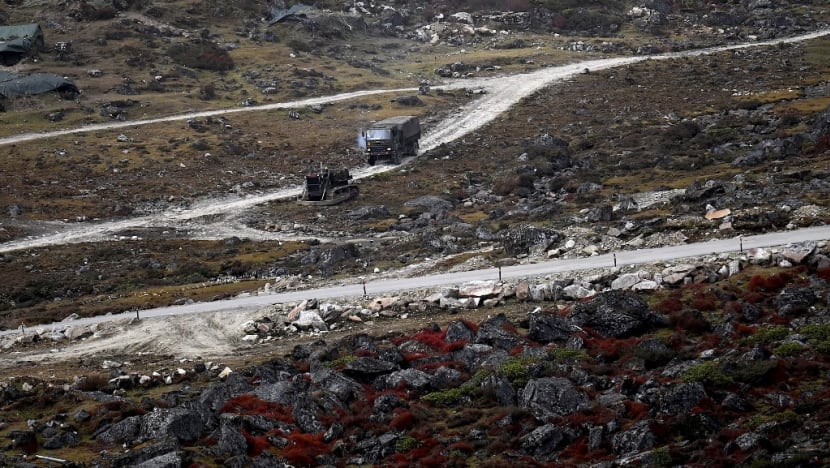China eyes status quo in border row, as India's broader geopolitical concerns grow: Analysts
The two countries have been caught in a standoff in India's northern region of Ladakh, a Himalayan border area between the two nations, which is now entering its fourth year.

NEW DELHI: The risk of possible escalation in the border row between India and China is mounting, with both sides having vastly different assessments of the conflict, according to analysts.
The two countries have been caught in a standoff in India's northern region of Ladakh, a Himalayan border area between the two nations, which is now entering its fourth year.
A series of diplomatic engagements this year revealed the differences in which both sides view the conflict, with China claiming the border is generally stable, while India maintaining that it is not and that ties with Beijing are abnormal.
It is the most tense bilateral ties have been in 60 years, after they last fought a war over border differences in 1962.
China and India were the second and fourth largest military spenders respectively in the world last year.
REFUSING TO BLINK FIRST
The standoff between the nuclear-armed neighbours began three years ago at the Galwan Valley in Ladakh, with violent deadly clashes taking place between troops.
Since then, 18 rounds of talks between military commanders have brought no success in ending the deadlock.
Dr Subrahmanyam Jaishankar, India’s External Affairs Minister, said last month: “I have made it very clear, publicly as well, that China-India relations are not normal and cannot be normal if peace and tranquillity in the border areas are disturbed.”
New Delhi accuses Chinese troops of transgressing into its territory, but Beijing has denied the charge, and even recently demanded the creation of a buffer zone with a width of between 15km and 20km, mostly within Indian territory.
China's insistence that all is well at the border is fuelling tensions between the two, as it seeks to maintain the status quo there, said experts.
Dr Brandon Yoder, senior lecturer at the Australian National University’s School of Politics and International Relations, said the main reason for the conflicting views is that China holds the “tactical upper hand on the ground in the border region”.
“It is in China's interest, and China desires a maintenance of that status quo in terms of the distribution of power there, and would like to maintain that leverage,” he told CNA’s Asia First on Thursday (Jun 15).
He said China has every incentive to downplay the conflict, especially with its growing geopolitical rivalry with the United States.
“India, on the other hand, is dissatisfied that China has this leverage in the Himalayan border region, and would like to be able to put deterrent pressure on China, to let China know that it can't simply continue to make these kinds of incursions to encroach on what India claims as its sovereign territory,” added Dr Yoder.
MORE ACCUSATIONS ENSUE
India's defence minister and foreign minister have both held engagements with their Chinese counterparts this year.
However, with Beijing suggesting New Delhi look at the big picture and not focus only on the border issue, the world’s most populous country has accused China of eroding the basis of their bilateral relations.
The conflict has marked a major shift in how New Delhi views China, said India's former Deputy National Security Advisor Pankaj Saran, who served from 2018 to 2021.
“Chinese actions were a wake up call. We have seen a more confident and more vocal expression of these concerns. These are facts that the Indian leadership is willing to put on the table and not mince words or back off from articulating,” he told CNA.
India is now accelerating and intensifying its links with other partners across the world, forging friendships and partnerships to help safeguard its national security, he said, adding that this is a “visible direction of change” in its foreign policy.

Next week, Prime Minister Narendra Modi will make his first state visit to the US, after nine years as leader of the country, taking India’s engagement with the US up a notch.
The White House said his visit will “affirm the deep and close partnership between the United States and India”.
New Delhi has also increased engagement with the other two members of the Quad, Japan and Australia, and is making a mark in the Indo-Pacific, an area where Washington and Beijing have been tussling for influence.
Last month, Mr Modi became the first Indian leader to visit Papua New Guinea, as the Pacific nation signed a security pact with the US.
“India sees China as a security threat and not only on the border, but more broadly in the region. They have a burgeoning geopolitical rivalry of their own in the Indian Ocean and with states on India's border,” said Dr Yoder.
“There are multiple security issues at stake in China-India relations, so India … wants to reduce its economic dependence on China and create security hedges. We see new attempts to diversify its economic portfolio so that it has other trading partners (and) security partnerships, like the Quad that India is increasingly leaning into.”

NOT LIMITED TO THE BORDER ANYMORE
Observers told CNA that China's provocations are no longer just limited to the border.
India's Home Minister Amit Shah travelled to the eastern state of Arunachal Pradesh in April and unveiled border infrastructure projects there, after China renamed 11 places in the region it calls “South Tibet”.
In response, the Chinese foreign ministry said it violated China’s territorial sovereignty and was “not conducive to the peace and tranquillity of the border situation".
Chinese President Xi Jinping will travel to Delhi in September this year for the G20 summit hosted by Mr Modi. While the two have not held talks in three years, analysts said that at this juncture, only talks at the very highest levels can help break the deadlock.
Dr Yoder said he expects the relationship between the two countries to remain “more of the same” in the foreseeable future.
“I could see China making minor concessions. I think a lot of the underlying issues here are image and status-based and domestic politics,” he explained.
Depending on how the war in Ukraine goes and how China-US relations progress, China may be inclined to make token concessions and “try to get India on board with the line that the Chinese leadership has taken”,” said Dr Yoder.














